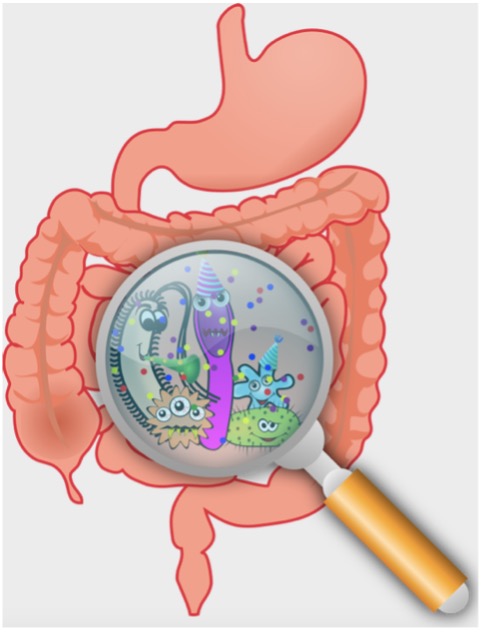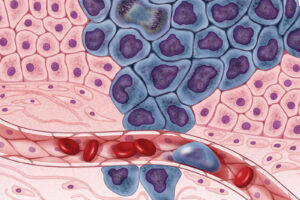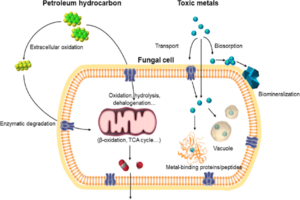
Figure 1: The human gut is home to a rich ecosystem of microbes. Recent research has highlighted the extent of viral diversification within the gut microbiome that has wide potential implications for human health
Source: Pixabay
Despite the intense focus on SARS-CoV-2, the ubiquity and diversity of viruses is extraordinary; after all they are the most populous biological entity inhabiting Earth (Koonin, 2010). Despite their association with human disease – for example flu, measles, and HIV – viruses infect many living organisms and their impact extends beyond just disease. Viruses that infect bacteria and archaea are called “bacteriophages” or simply just “phages”. They play a fundamental role in driving microbial evolution and ecosystem dynamics. The understanding of these complex interactions, however, remains in its infancy. In a recent metagenomic study Camarillo-Guerrero et al. (2021) sought to characterise the human gut virome, identifying the presence and prevalence of different phage types.
In this study, the researchers genetically sequenced and analysed 28,060 human gut samples from across the world in a process known as metagenomic analysis. From the results, they created a Gut Phage Database, consisting of 142,809 bacteriophage genomes. Many of these phage genomes were previously unidentified and thus the results shed greater light onto the huge diversity of resident viruses within the human body. These identified bacteriophages were categorised by their bacterial hosts. It was found that 36% had a host range extending beyond one bacterial species, indicating phages’ important role in supporting intra- and inter-species gene transfer between bacteria in the gut microbiota. Bacteriophages are able to transfer genetic material between infected bacterial hosts, a process referred to as transduction. Virus-mediated gene exchange supports bacterial diversification and the acquisition of extra functions, which can be beneficial for the bacterial host. Such functions can include antibiotic resistance – a major concern for the treatment of bacterial diseases (Beller & Matthijnssens, 2019). The gut phageome is determined by the bacteria present and shaped by human lifestyle. Epidemiological analysis of the database of viral genomes generated in the study identified a clear correlation of certain bacteriophages with urban and rural lifestyles. For example, in urban samples bacteriophages targeted Bacteroides over Prevotellaceae bacteria. However, the reverse was found in rural samples. Such findings demonstrate the complex plasticity of the gut microbiome, which is driven by human lifestyle, and more specifically urbanisation (Camarillo-Guerrero et al. 2021).
What does all this mean for human health and disease? The bacterial component of the gut microbiome has been strongly associated with many disease states including gastro-intestinal and auto-immune diseases (Blum, 2017). It is clear that bacteriophages aid in shaping the bacterial ecosystem living within the human gut. However, our understanding of the role each phage type plays remains to be uncovered. A number of studies have acknowledged a specific link between gut bacteriophage composition and disease, including type 1 diabetes and colorectal cancer (Beller & Matthijnssens, 2019). Whether the presence of certain phages is a cause or consequence of the disease remains unresolved. The development of the Gut Phage Database by Camarillo-Guerrero et al. (2021) has demonstrated the huge diversity of gut bacteriophages, serving to aid future investigation into the complex dynamics of the gut ecosystem and its implications for human health.
References
Beller, L., & Matthijnssens, J. (2019). What is (not) known about the dynamics of the human gut virome in health and disease. Current Opinion in Virology, 37, 52–57. https://doi.org/10.1016/j.coviro.2019.05.013
Blum, H. E. (2017). The human microbiome. Advances in Medical Sciences, 62(2), 414–420. https://doi.org/10.1016/j.advms.2017.04.005
Camarillo-Guerrero, L. F., Almeida, A., Rangel-Pineros, G., Finn, R. D., & Lawley, T. D. (2021). Massive expansion of human gut bacteriophage diversity. Cell, 184(4), 1098-1109.e9. https://doi.org/10.1016/j.cell.2021.01.029
Koonin, E. V. (2010). The wonder world of microbial viruses. Expert Review of Anti-Infective Therapy, 8(10), 1097–1099. https://doi.org/10.1586/eri.10.96
Related Posts
Modeling Maximum Running Speed in Animals
Figure: Two cheetahs lie side by side. As the fastest...
Read MoreSingle Cell RNA Sequencing Enhances Understanding of Tumor Genetic Diversity
Figure 1: Researchers have shown that tumor cells are a...
Read MoreMixed fungal cultures: a more potent method of crude oil biodegradation
A diagram showing how a fungal cell combines with the...
Read MoreMegan McGrath




Comments are closed.